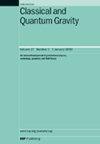洞察双中子星合并模拟:多代码比较
IF 3.7
3区 物理与天体物理
Q2 ASTRONOMY & ASTROPHYSICS
引用次数: 0
摘要
来自双中子星(BNS)合并的引力波(GW)信号为了解极端条件下物质的性质提供了关键的见解。由于观测资料的缺乏,数值相对论(NR)模拟对于探索这些现象是必不可少的,而不是取代观测证实的需要。然而,模拟BNS合并是一项艰巨的挑战,确保一致性、可靠性或收敛性,特别是在合并后,仍然是一项有待完成的工作。在本文中,我们通过分析来自五个领先的NR代码(SACRA, BAM, THC, Whisky和SpEC)的开源GW波形来评估当前BNS合并模拟的性能。我们重点关注这些模拟的准确性以及状态方程对波形预测的影响。我们首先检查不同的代码是否对相似的初始数据给出相似的结果,然后应用两种方法计算收敛性和量化离散化误差。最后,我们对潮汐相互作用对GW频谱中关键频率的影响进行了深入的研究。我们引入了一种新的瞬态合并后时间的准普适关系,增强了我们对该区域残余动力学的理解。这一详细的分析澄清了这些领先的NR代码之间的协议和差异,并强调了未来GW探测器先进精度要求的必要改进。本文章由计算机程序翻译,如有差异,请以英文原文为准。
Insights into binary neutron star merger simulations: a multi-code comparison
Gravitational Wave (GW) signals from binary neutron star (BNS) mergers provide critical insights into the properties of matter under extreme conditions. Due to the scarcity of observational data, numerical relativity (NR) simulations are indispensable for exploring these phenomena, without replacing the need for observational confirmation. However, simulating BNS mergers is a formidable challenge, and ensuring the consistency, reliability or convergence, especially in the post-merger, remains a work in progress. In this paper we assess the performance of current BNS merger simulations by analyzing open-source GW waveforms from five leading NR codes – SACRA, BAM, THC, Whisky, and SpEC. We focus on the accuracy of these simulations and on the effect of the equation of state on waveform predictions. We first check if different codes give similar results for similar initial data, then apply two methods to calculate convergence and quantify discretization errors. Lastly, we perform a thorough investigation into the effect of tidal interactions on key frequencies in the GW spectrum. We introduce a novel quasi-universal relation for the transient post-merger time, enhancing our understanding of remnant dynamics in this region. This detailed analysis clarifies agreements and discrepancies between these leading NR codes, and highlights necessary improvements for the advanced accuracy requirements of future GW detectors.
求助全文
通过发布文献求助,成功后即可免费获取论文全文。
去求助
来源期刊

Classical and Quantum Gravity
物理-天文与天体物理
CiteScore
7.00
自引率
8.60%
发文量
301
审稿时长
2-4 weeks
期刊介绍:
Classical and Quantum Gravity is an established journal for physicists, mathematicians and cosmologists in the fields of gravitation and the theory of spacetime. The journal is now the acknowledged world leader in classical relativity and all areas of quantum gravity.
 求助内容:
求助内容: 应助结果提醒方式:
应助结果提醒方式:


